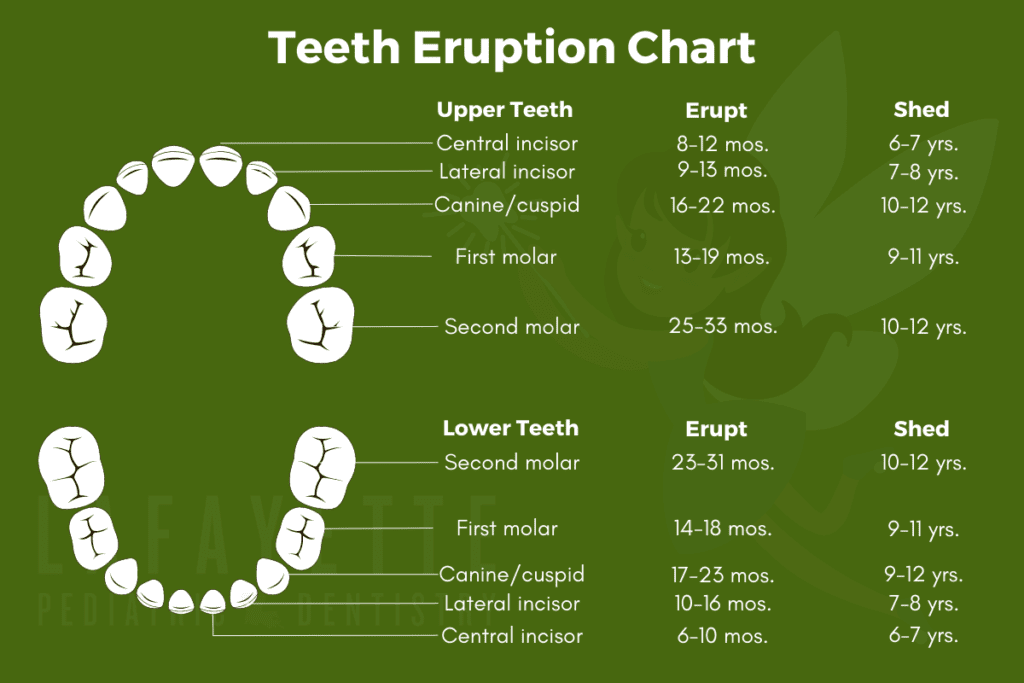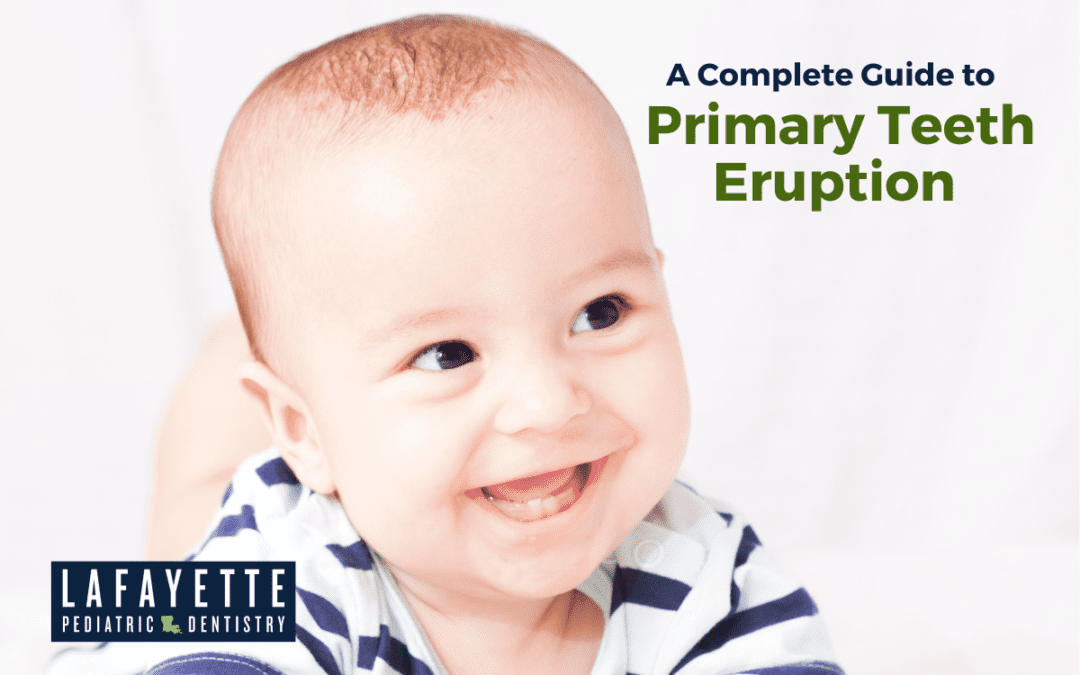Raising a child can be both an exciting and overwhelming experience, especially in the early stages. This is particularly true when it comes to navigating primary teeth eruption.
With so many myths and advice on what to do (or not do!) for your baby’s pearly whites, it can be difficult for new parents to get their heads around what’s actually happening beneath their baby’s smile.
This guide will take you through everything you need to know: from knowing exactly which tooth will come first, helping your little one through the teething stage, and more!
Why Are Primary Teeth Important?
You may be wondering why your baby’s primary teeth are important since they will fall out anyway. Maintaining primary teeth, also known as baby teeth, is crucial for a child’s oral and overall health. Primary teeth play vital roles in:
- Facilitating proper chewing and eating. Primary teeth allow your child to eat a variety of solid, nutritious foods that promote a healthy body.
- Allowing the proper development of jawbones and muscles. Proper chewing with baby teeth is essential for strengthening the jaw muscles. Insufficiently developed jaw muscles may result in improper development of your baby’s jawbones.
- Creating room for permanent teeth and directing them to the correct position. Primary teeth hold the space for permanent teeth. If a primary tooth falls out too early due to a cavity or other oral issues, the adjacent teeth can shift into the gap and impede the incoming permanent tooth, which can result in dental crowding.
- Contributing to the development of speech. Teeth are important in helping your baby speak properly. If your child is missing a primary tooth or two, they may have difficulty making certain sounds, such as “th” or “la”, which can impact their speech patterns.
- Contributing to an attractive appearance. Healthy primary teeth can boost your child’s self-confidence and create positive social experiences.
The Importance of Understanding Primary Teeth Eruption Stages for Parents
Knowing when to expect your child’s teeth to grow will help you prepare for the teething period and ensure that they receive the necessary oral care at every stage.
This knowledge can also help identify any potential issues early on. So, take the time to learn about the primary teeth eruption process and empower yourself as a parent to give your child the best oral health care possible.
Teeth Eruption Stages
Children’s teeth actually begin forming before birth. The first primary teeth to erupt are the lower central incisors, which can come in on average at 7 months of age, followed closely by the upper central incisors, typically four months later.
The other sets of teeth usually come in four month increments until all 20 primary teeth appear, usually by the time your child is three years old.
While the average age of the first tooth to erupt is 7.5 months, the timing can vary greatly. Some children may even get their first tooth at 4 months or well after their first birthday! So, if your child’s primary teeth don’t come in within this time range listed below, don’t panic!

How Do I Know if My Baby is Teething?
It can be difficult to know what to expect when it comes to your baby’s development phases, especially teething. So, how do you know when your baby is teething? Look out for tell-tale signs below:
- Unexplained fussiness or irritability
- Continuously chew or gnaw on their fingers or fists
- Trouble sleeping
- Red or swollen gums
- Excessive drooling
- Low-grade fever
- Loss of appetite
Don’t worry if your baby shows some of these symptoms a few months before their first tooth pops through – it’s all part of the teething process. Just remember to keep a watchful eye on them and offer plenty of love and support during this exciting but challenging milestone.
How Do I Soothe My Teething Child?
Teething can be a difficult time for both you and your child. Seeing them in pain and discomfort can be heart-wrenching. Fortunately, there are tried and true ways to soothe your teething child to make this period more bearable.
- Gum massage. Use a silicone brush or finger cot to gently rub your baby’s tender gums in circular motions.
- Frozen fruit purees. Fill a mesh feeder with your child’s favorite fruit puree and freeze it. Let it sit so it doesn’t get too cold for your kid, and apply it on top of the gums to soothe them.
- Breastmilk/formula popsicles. Freeze breastmilk/formula using a popsicle mold. Let it sit for a bit before placing it on their gums so it’s not too cold. You can also use a silicone straw as opposed to a popsicle mold. Tape over one end of the straw, fill it with milk, and freeze it.
- Frozen washcloth or pacifier. Dampen a washcloth or pacifier and then freeze it. Let it sit for a few minutes before applying it on top of your baby’s gums.
- Teething toys. Choose a teething toy that’s made of a single piece of solid rubber or silicone, since those liquid-filled or plastic-made toys with multiple attachments could break when your baby chews on them, which could be a choking hazard and develop sharp edges. We do NOT recommend anything that goes around the neck, such as an amber teething necklace, which can also be a choking hazard.
- All Natural Teething Gels. Opt for teething gels that contain natural ingredients, such as chamomile, rosehip, and clove oil, since they’re safer for kids. Make sure to avoid products containing Benzocaine (such as Anbesol or Orajel) and Belladonna. Benzocaine can greatly reduce the amount of red blood cells in the body, a condition called methemoglobinemia, which can be fatal.
- Other medications. If none of the above teething relief works, it’s okay to use Infants’ Tylenol every four hours. If your baby is over 6 months old, use Ibuprofen every 6 hours. Make sure to dose appropriately according to your baby’s weight.
It’s also important to never leave your baby unattended while chewing or sucking on foreign items such as popsicles, washcloths, and toys to prevent choking. And remember to always be patient and loving with your little one during this time, and rest assured that the discomfort will pass soon enough.
Caring for Your Child’s Primary Teeth
Fortunately, taking care of those little pearly whites is very easy! As you see these little teeth coming through, gently brush them twice a day using a small, wet soft-bristled baby toothbrush.
Once your child has more teeth, add a tiny smear (about the size of a grain of rice) of fluoride toothpaste to your child’s daily oral hygiene regime. It is ok if your child swallows the toothpaste, as the ingested fluoride is beneficial to the developing permanent teeth, so long as it is only a rice grain-sized amount!
When your child has two teeth that touch each other on the sides, start using dental floss gently to remove food particles in between. Trust us, your baby (and their teeth) will thank you in the long run!
Delayed Tooth Eruption: Should I Be Worried?
While the first baby tooth can erupt as early as four months, sometimes it comes in much later, and this undoubtedly leaves parents worried. The good news is, it’s completely normal!
However, there are several factors that may contribute to delayed tooth eruption, such as premature birth, nutrition deficiency, low birthweight, medical syndromes, and developmental disorders.
But if none of these apply to your baby and they are otherwise healthy, then there’s nothing to be concerned about. As we have mentioned above, some children may even have the first tooth closer or after their first birthday.
Even though delayed tooth eruption typically isn’t something to be worried about, you should still schedule your child’s first dental visit by the age of 1 so that they can receive preventive treatment, if necessary, before any issues develop.
Your child should also visit a pediatric dentist as soon as their first tooth erupts because the dentist can advise the best ways to keep your child’s primary teeth healthy.
Read more: Understanding Your Child’s Irregular Tooth Growth: Advice from Our Dental Experts
Hopefully, you now have a better understanding of primary tooth eruption so you can ensure your little one’s overall health and well-being. We also recommend speaking with your local pediatric dentist if there are any concerns or questions regarding your child’s progress with their emerging teeth.
Our pediatric dental specialists at Lafayette Pediatric Dentistry are always available to offer the most comprehensive dental services tailored specifically to meet the needs of our youngest patients. Don’t hesitate to reach out so we can help to get your little one’s smile off to a healthy start!
Sources:
